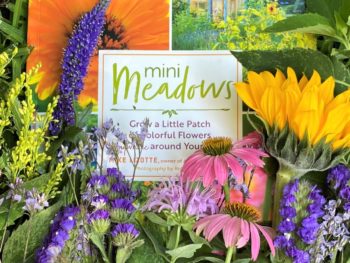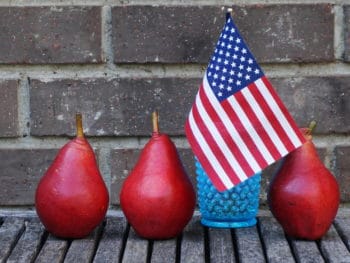A remarkable coincidence has occurred this year: Two books have been published about Bible plants, highlighting the multitude of horticultural meaning hidden in the ancient Scriptures. God’s Word for Gardeners Bible was published this spring,

Author Opposites
Amazing is the great spectrum stretching between me and Jo Ann Gardner, respective authors of these works: We could not be more opposite! Gardner is a life-long farmer and established author. She and her husband, Jigs Gardner, farmed in Nova Scotia for 30 years, relying wholeheartedly on their yields, now keeping a small farm in New York. I am a suburbanite in Texas (my husband has a “normal” job!) whose gardening adventures are just getting started, adding a few fresh ingredients to our family’s meals but still thankful for the grocery store nearby.
Furthermore, as “It was inevitable,” Gardner writes,”that I would feel the need to see and touch, and even taste, the plants I had read about…,” Gardner traveled to Israel, gleaning and working alongside Nogah Hareuveni, founder of Neot Kedumim, the Biblical Nature Preserve. She spent many years lecturing and keeping company with contemporary Bible plant scholars. I am completely new to the field, soaking up all they have written, imagining the Holy Land via their descriptions and images. My “inevitable” need to see, touch, and taste the plants has been satisfied by what I can plant and bring to table from my own backyard (for now!).
Finally, Gardner focuses her work primarily in the Torah, while I have embraced the horticulture of the Hebrew Bible and followed its trail into the New Testament.
Yet anyone familiar with God’s ways will recognize the “merism” (see below) in our viewpoints at once—that mesmerizing literary technique in Hebrew of using two extremes to imply everything in between—shown in such Scriptures as:
as far as the east is from the west, so far has he removed our transgressions from us
Psalm 103:12 NIV
so that from the rising of the sun
to the place of its setting
people may know there is none besides me
Isaiah 45:6 NIV
I have learned the secret of being content in any and every situation,
whether well fed or hungry,
whether living in plenty or in want.
I can do all this through him who gives me strength.
Philippians 4:12-13 NIV
What do I conclude from these horticultural works, growing up near the beginning of the year and its end? God is trying to get our attention! O gardeners, He is ready to pour out his wisdom, revelation, salvation, not mention his sense of humor and delight, to a new generation of people who seek the health, healing, peace, and sheer joy of a life connected to the land.
Gardner’s Seeds of Transcendence
I have just “dug in” to Seeds of Transcendence and already found precious details that make me smitten with God’s Word. Gardner relates that if indeed Noah’s ark was made from cypress wood (for the meaning of the Hebrew word for this wood remains uncertain)—
So make yourself an ark of cypress wood
Genesis 6:14 NIV
this detail amplifies Noah’s role as comforter and healer, the cypress known as an “earth healer” for its longevity and beneficial effects on the soil (Seeds of Transcendence, page 14). These layers and so many more that Gardner discusses make Seeds of Transcendence a wealth of insight 
Though we come from contrasting circumstances, I share Gardner’s great hope in publishing a resource to spark curiosity; as she wrote,
“I know I will have succeeded in this aim when someone who was never interested in the Bible, picks up this book, reads a chapter or two, feels compelled to read on, and then to read in the Bible itself.”
Amen.
Seeds of Transcendence: Understanding the Hebrew Bible Through Plants, © 2014 by Jo Ann Gardner available at her website www.joanngardnerbooks.com and Amazon.com
Merism, as defined by Dr. John Sailhamer, is a Hebrew figure of speech that “expresses ‘totality’ by combining two contrasts or two extremes.” Quotation from Genesis Unbound (Sisters, Ore.: Multnomah, 1996), page 56.
Photo Captions: Featured image screen-captured from Lemnius Levinus, An Herball for the Bible, translated by Thomas Newton (London: Edmund Bolifant, 1587). Search for this Bible plant classic on Google Books.
© 2014 Shelley S. Cramm Stack of Bible plant books from our era, old friends by now!













